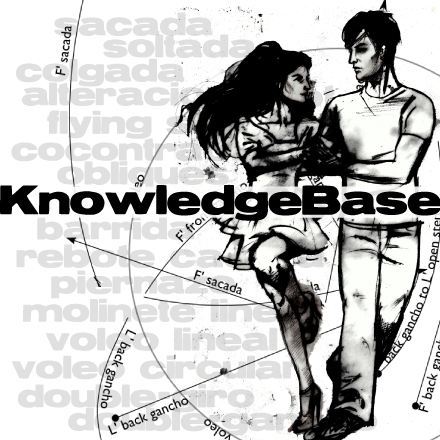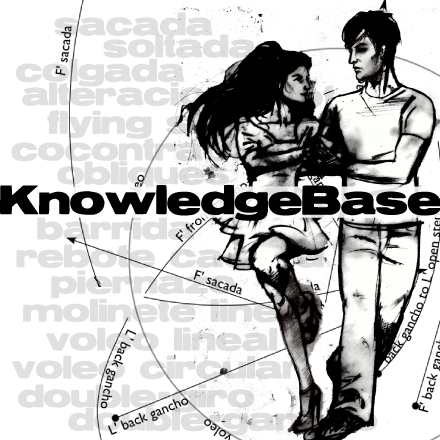Is the embrace the source of our connection? No. The embrace is the last mile. We position the lower body into an arc and aim it at our partner’s base leg to create an arch of connection. The embrace completes the arch of connection. To keep the embrace taut and agile, we use only two instructions:
- external rotation of the shoulders (to keep information flowing from the body through the embrace)
- gentle contraction of the triceps muscles (to stabilize the elbow joint, so that it won’t easily flex or extend in response to small changes in force by the partner, and to keep the muscle pair (biceps+triceps) on alert, ready to respond to movements with larger forces, such as voleos, ganchos, and leaning movements)

The Revel is responsible for connection
 She takes responsibility for getting information from her Mark. She does this by maintaining contact with her fingertips and the blade of her hand (and her chest in close embrac). She adjusts the position of her body and hands to be sure she can perceive his intention in at least four directions (toward him, away from him, lateral left or right to him).
She takes responsibility for getting information from her Mark. She does this by maintaining contact with her fingertips and the blade of her hand (and her chest in close embrac). She adjusts the position of her body and hands to be sure she can perceive his intention in at least four directions (toward him, away from him, lateral left or right to him).
Her fingerpads are responsible for sensing pull connection, when the Mark expresses intention for her to project toward him or lateral to him).
The blade of her hand (and her chest in close embrace) is responsible for sensing push connection, as the Mark expresses intention for her to project away from him.
In closer embraces when her left hand is on the Mark’s back, its work of its blade is replaced by her chest (when touching his), or in a slightly open embrace, by the inside of her upper arm. As the embrace shifts, she should slide her hand to a comfortable place. It may be anywhere from his wrist to his thigh, but she needs to stay in contact. If she cannot make contact with her left hand, she can use the inside of her left arm, using light pressure and friction to keep the contact and get the information she needs.
 In open embrace, beginners may get the most information with their hands wrapped just under the mark’s deltoid using the heel of the hand to feel the mark’s forward motion and the fingertips to perceive backward motion. As the revel advances, she will be able to feel with a lighter and lighter touch, but she must always be sure that her left hand, arm and chest (in close embrace) are positioned to perceive movement in three directions.
In open embrace, beginners may get the most information with their hands wrapped just under the mark’s deltoid using the heel of the hand to feel the mark’s forward motion and the fingertips to perceive backward motion. As the revel advances, she will be able to feel with a lighter and lighter touch, but she must always be sure that her left hand, arm and chest (in close embrace) are positioned to perceive movement in three directions.
For the Mark, the embrace is a conduit for the power and information coming from his legs.
If the Mark shows intention by pushing with his hands or tugging with his fingers, the revel will have to compensate excessively to synchronize the transfer of weight at the same time. If she doesn’t know how to do this (or gets tired of compensating) the partners will not transfer at the same time. He should meet her body with his arc of muscles and use that arc to direct push and pull on her points of connection.
If the mark grips the revel with his fingers, he can easily break her arch, and he will also prevent her from sensing accurately.
The revel should not feel the mark’s hands, but the power of his whole body. It’s nice to give feedback to your partner this way. “I feel your hands. I want to feel your body.”
There is no reason for the mark to hold his left hand above anyone’s shoulder – hers or his own.
He should keep his right arm well below her armpit, so that he does not pull her arm upward and tilt her spine.
The palms of his hands should face her heart. This ensures that the work of his lower body is directed toward her.


Adjusting the embrace
The revel is responsible to adjust her contact points as necessary, as she moves from closest embrace, across the back, all the way down the arm to to the wrist, to a complete soltada (release). In soltada she should seek with whichever hand is nearest to him a light contact with whatever part of his body is available, back, stomach, elbow, back of the hand…
When adjusting the embrace, partners should slide their hands along the body to the new position rather than jumping the hands through the air. This ensures continuous connection.
Change of embrace is an important part of the intention for advanced movements. We use changes in the position of joints to change the embrace.
Specifications
BASIC stabilization of the embrace (applies to every position)
- external rotation of the shoulder joints
- 50% contraction of triceps to stabilize elbow joint flexion angle
- extension of wrist joint
DIRECTIONAL stabilization of the embrace
- motion toward or away from the mark: 50% contraction of anterior deltoids to stabilize shoulder flexion angle
- lateral motion: contraction of supraspinatus of the arm in the direction of the motion, relaxation of the other one
CHANGES of embrace












